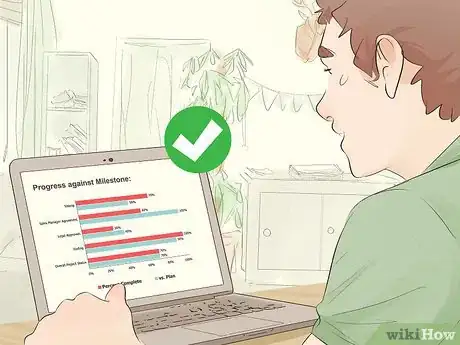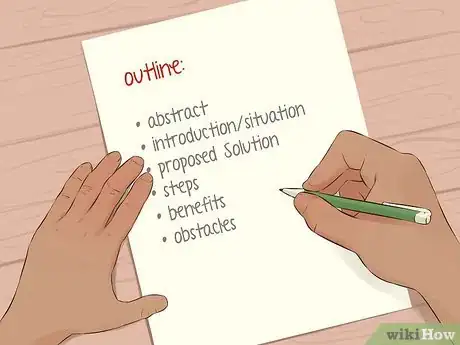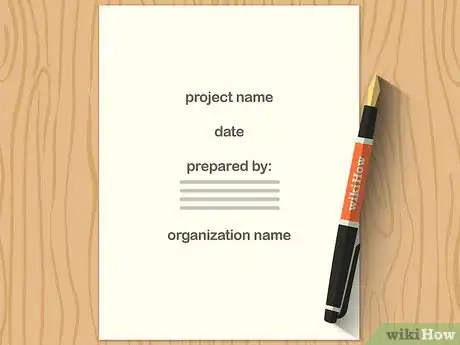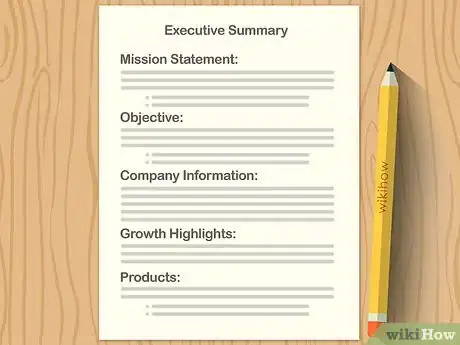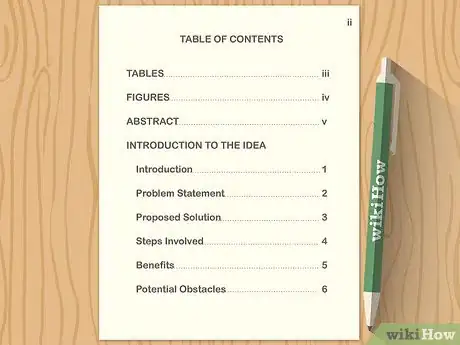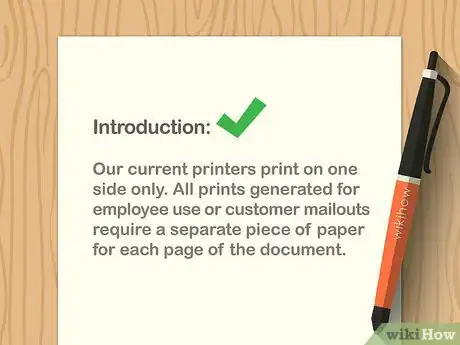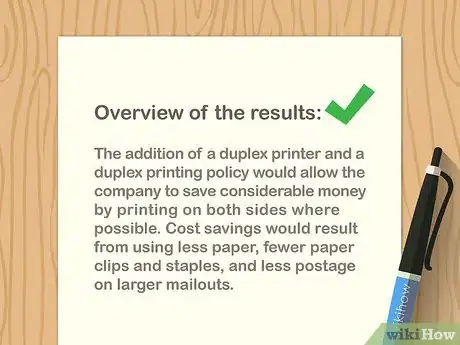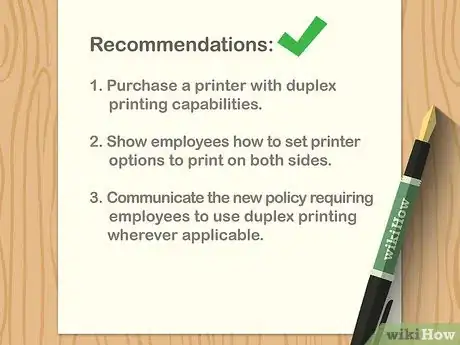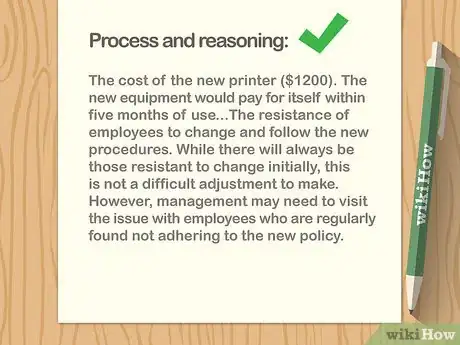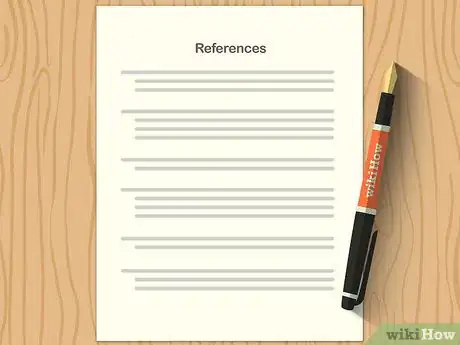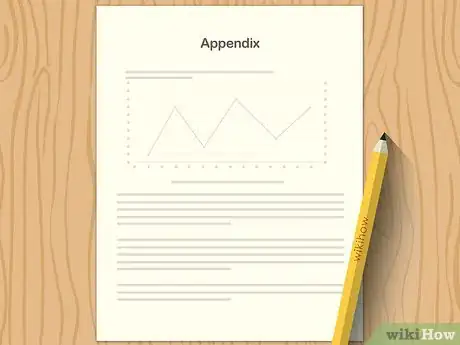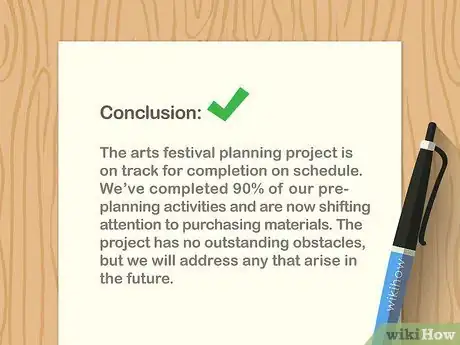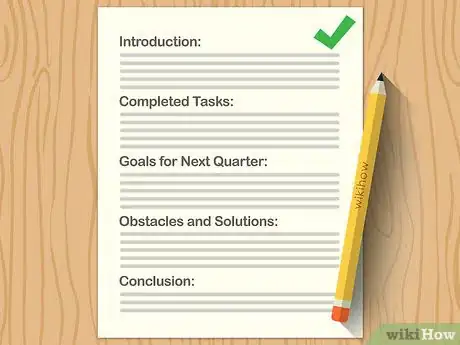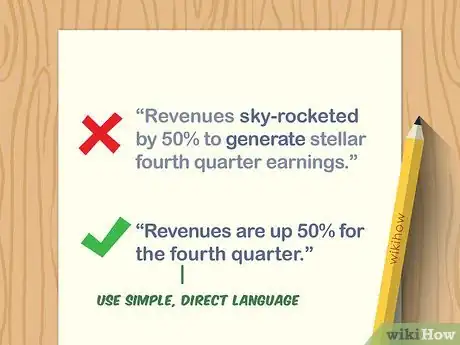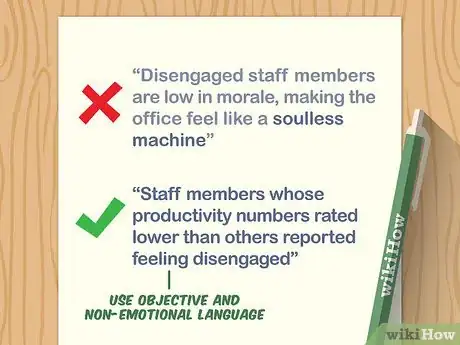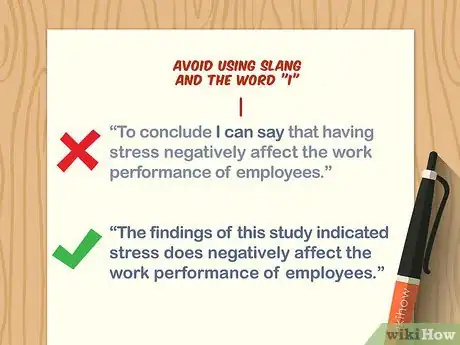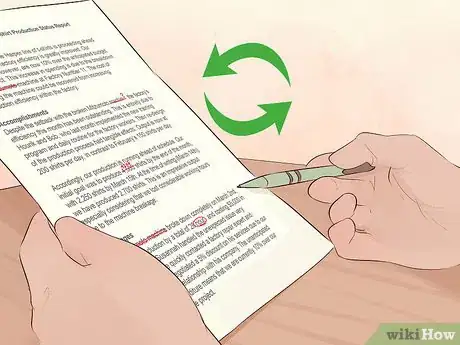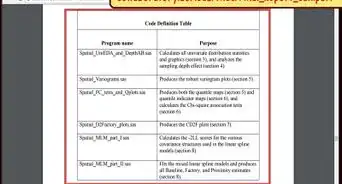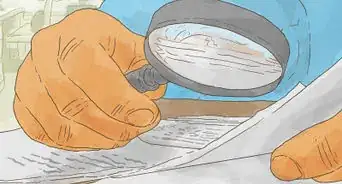This article was co-authored by Madison Boehm and by wikiHow staff writer, Danielle Blinka, MA, MPA. Madison Boehm is a Business Advisor and the Co-Founder of Jaxson Maximus, a men’s salon and custom clothiers based in southern Florida. She specializes in business development, operations, and finance. Additionally, she has experience in the salon, clothing, and retail sectors. Madison holds a BBA in Entrepreneurship and Marketing from The University of Houston.
There are 10 references cited in this article, which can be found at the bottom of the page.
This article has been viewed 146,690 times.
Writing a work report might feel overwhelming, but it might be easier than you think. Work reports are typically used to explain your progress on a work project or provide your conclusions and recommendations regarding a workplace issue. To easily write an effective work report, start by considering your purpose, audience, research, and message. Then, draft your report using a typical format for business reports. Finally, you can revise the report to make it effective.
Steps
Planning a Work Report
-
1Identify the purpose and topic of your report. In some cases, you may have been asked for a report. Your purpose or topic will likely be included in the request. If you’re not sure about your purpose or topic, consider what message you’re sending to your audience. You can also talk to your boss or supervisor for clarification.[1]
- For example, your purpose may be to analyze a business issue, explain the results of a project you worked on, or provide your supervisor with an overview of your work progress.[2]
-
2Choose a tone and language that fits your audience. Consider what your audience will already know, as well as the level of jargon they will understand. When writing a work report, you can often use more professional language and jargon than when writing for the general public.[3]
- Who all will read your report? Include anyone who might reasonably use the report in your audience.
- If you’re writing for different types of readers, include all necessary information for your least informed reader to understand. However, use headings for each section so that informed readers can skip information that is redundant for them.[4] You might also include sections for each audience to address their concerns.
Advertisement -
3Gather your research and supporting materials, if applicable. Include the materials you’ve used to reach your conclusions or develop your recommendations. You’ll refer to these materials as you prepare your report, plus you may need to include them in the appendices of your report. Here are the types of materials you might include when preparing your report:[5]
- Financial information
- Charts
- Graphs
- Statistical information
- Surveys
- Questionnaires
- Interviews with experts, coworkers, clients, etc.
-
4Review your progress if you’re writing a progress report. A good progress report will provide a quick overview of the work you’ve done, what you’re about to do next, and whether or not the project is on track. It’s best to think of it as an answer to questions people might have about your project. Here are the things to include in your report:[6]
- Has the project scope changed?
- What tasks have you done since the last progress report?
- What tasks are you going to do next?
- Are you on track to complete the project on time? If not, why?
- What obstacles have you encountered, and how will you overcome them?
- Did you learn any lessons this month?
-
5Outline the information you need to include in your report. Jot down your ideas in a loose outline to help guide your writing. As you outline, develop headings for your report to help you organize what you need to say. Your outline doesn't need to be neat or well-developed, as it’s only for your use.[7]
- In most cases, you’ll start your report by explaining your results, conclusions, or recommendations. Then, explain how you got to this point and your reasoning, if applicable.
- If you are about to make a controversial conclusion or recommendation, explain your process and reasoning first so your audience will be able to understand why you arrived at this idea.
Drafting a Work Report
-
1Use a cover or title page. Your title page should provide the name of your report, followed by the date you submitted it on a separate line. On a third line, list the names of all authors. Then, write the name of your organization on a fourth line.[8]
- In some cases, you might also include a cover letter to explain why you wrote the report, what it includes, and what you think needs to be done next. This is more common for reports that have taken a long time to prepare or require an additional explanation before the reader looks at the report itself.
- For a progress report, list your name, project name, date, and reporting period on a title page. Put each item on a separate line. You can label each line with “name,” “project name,” “date,” and “reporting period,” or you can just list the information.[9]
- Ask your boss if there are specific recommendations for formatting your work report. They’re your best resource for preparing your report.
-
2Provide an executive summary detailing the key information. Include your conclusions, justifications, and recommendations. This allows someone to understand the main points of your report without reading the entire paper. You don’t need to write a detailed explanation, but the reader should understand what the report is about. Your executive summary should be .5 to 1 page long.[10]
- You don’t need to summarize the entire report. Just focus on the most important ideas in the report, such as the key recommendations or conclusions you’re presenting.
- If you’re writing a progress report, you can skip this section.
-
3Include a table of contents listing what’s in your report. List the section headings in the table of contents, as well as the page numbers where that section starts. This allows your readers to easily navigate your report and find the information they need.[11]
- Use titles and headers for each section so your report is easy to read.
- If you’re writing a progress report, you usually don’t need to include a table of contents, unless your boss prefers that you do. However, include titles and headers for each section to make it easier to navigate your report.
-
4Write an introduction to provide an overview of the report. Tell the reader what prompted you to write this work report. Summarize the context surrounding the report, and explain your purpose. Preview the questions you’ll answer or the issue you’ll solve. Give the scope of your report, as well as a road map of its contents.[12]
- Your introduction doesn’t need to be long. Be direct and specific so that your reader will understand the context and purpose without a lengthy explanation.
- Write 2-4 paragraphs for your introduction.
- For a progress report, your introduction should only be 1-2 paragraphs long. It should summarize your project and what you hope to accomplish. You might also preview the work you’ve completed and what you plan to do next.
-
5Explain the results or conclusions you’re presenting. Give a basic overview of the research or evaluations you’ve completed related to this project. Then, discuss and interpret your findings and how they relate back to the topic of your report.[13]
- In most cases, this section will include an introductory paragraph and a list of the conclusions you reached.
- Here’s what a conclusion might look like: “1. Our population is aging, leading to more health risks among our clientele.”
- If you’re writing a progress report, you won’t have any results or conclusions to present. Instead, list your accomplishments or completed tasks in the section after your introduction. You might also provide a short 2-4 sentence paragraph in this section. However, a list is usually sufficient. You might list “Raised $200 to pay for festival tent,” “Contracted with Your Party Plan to manage festival planning,” and “Surveyed 1500 residents to gather public input.”[14]
-
6Give your recommendations for moving forward. Your recommendations should explain what will happen in the future. Explain what your solutions will solve, and how they relate back to your conclusions. After writing your explanation, provide your recommendations in a numbered list, starting each one with a verb. List your recommendations from most important to least important.
- For example, you might write, “1. Train all employees to perform CPR.”
- If you’re writing a progress report, you’ll instead list the next tasks or goals that you plan to accomplish in your upcoming work period. For example, you might list “Find vendors for the festival,” “Approve festival designs,” and “Order promotional posters.”[15]
-
7Discuss your process and reasoning for reaching your conclusions. Explain how you approached the topic, issue, or problem. Review your findings, then explain how they lead to your recommendations. Separate your discussion into different sections with headings that tell your reader what’s included in that section.[16]
- This includes a lengthier discussion of your research and evaluations.
- This section should be the longest in your report.
- If you’re writing a progress report, you can skip this section. In its place, include a section on the obstacles you faced while working on the project, as well as how you overcame them.[17] You might write, “Many residents didn’t return the survey because it didn’t include prepaid postage. Moving forward, we’ll include postage on our surveys or give residents the option of doing their survey digitally.”
-
8List any references you used in preparing your report. References might include journal articles, news articles, interviews, surveys, questionnaires, statistical findings, and other related information. Cite these references at the end of your report, labeling the page “References.”
- Unless otherwise instructed, use APA formatting for business reports.
- You can skip this section if you’re preparing a progress report.
-
9Provide appendices for materials like surveys, questionnaires, or emails. Not every work report needs appendices. However, you might include them if you want to provide your reader with materials you’ve referenced or additional information that might help them better understand the topic or your findings. Label each appendix with a separate letter.[18]
- For example, you might have “Appendix A,” “Appendix B,” and “Appendix C.”
- If you’re writing a progress report, you don’t need to include this section.
-
10Include a short conclusion summarizing your findings or progress. You may not need to include a conclusion, but writing one can provide a nice recap of your efforts. Keep your conclusion to 3-4 sentences summarizing the information you’ve presented in your report.[19]
- You might write, “The arts festival planning project is on track for completion on schedule. We’ve completed 90% of our pre-planning activities and are now shifting attention to purchasing materials. The project has no outstanding obstacles, but we will address any that arise in the future.”
Making Your Report Effective
-
1Use clear headings to help your audience navigate the report. Create headings that are direct and straight to the point. The reader should know exactly what your report includes.
- Your headings might include: Introduction, Completed Tasks, Goals for Next Quarter, Obstacles and Solutions, and Conclusion.
- Tailor your headings to fit the information in your report.
- For a progress report, your audience will likely be your supervisor, team, or clients.[20]
-
2Use simple, direct language to convey your ideas. A work report doesn't need to include big words and creative sentences. You just need to get your point across to the reader. Express your ideas in the simplest words possible, getting right to the point.[21]
- You would write, "Revenues are up 50% for the fourth quarter," rather than, "Revenues sky-rocketed by 50% to generate stellar fourth quarter earnings."
-
3Use concise writing to keep your report as brief as possible. Writing more than necessary wastes both your time and the time of your readers. Cut the fluff and get straight to your point.[22]
- Keep in mind that some work reports may be long, as they may cover a lot of information. However, your writing should still be concise.
- It's okay to write, "Sales increased over the last quarter after the sales staff implemented cold calling," rather than, "We saw an exponential increase in revenues over the past selling quarter as our talented, dedicated sales people began cold calling potential clients to ask them to purchase more products."
- First, give an overall summary of the business. It should not be long. You have to grab the reader's attention right away. Or else no one will read a 100-page document.[23]
- Then give an overall snapshot of where you are at financially, where you are in terms of the business and the team.[24]
- After that, go into your past report and show that you have been making revenue in the current year. Then mention that you will try to take the business in a particular direction based on the trends.
-
4Express your ideas using objective and non-emotional language. Stick to the facts and let the reader draw conclusions based on an objective view of the subject. While you may be making recommendations for how to proceed on an issue, don't try to evoke the reader's emotions to persuade them. Allow the reader to form their own ideas and judgement based on an objective view of the facts.[25]
- Rather than writing, "Disengaged staff members are low in morale, making the office feel like a soulless machine," you could write, "Staff members whose productivity numbers rated lower than others reported feeling disengaged."
-
5Avoid using slang, as well as the word "I" in most reports. It may be appropriate to use "I" in a progress report, if you're writing about a project that you are working on alone. Otherwise, don't use the word "I" or any slang words in your work report. However, it's okay to use "you" when you're directing a sentence toward your intended reader.[26]
- Keep your language professional throughout your report.
-
6Proofread your report to ensure it doesn't contain errors. Grammar and spelling errors will undermine the professionalism of your work report. It's essential that you read over the report to make sure you don't have typos, poor phrasing, or incorrectly used words. It's best to proofread your report at least twice.[27]
- If you can, have someone else proofread your report for you, as it's difficult to spot all of your own mistakes.
- If time allows, set aside your report for at least 24 hours before you proofread it.
Outline for a Work Report
Warnings
- If you’re using an existing report as an example, don’t copy the wording in that report. This is plagiarism and will likely result in you facing professional consequences.⧼thumbs_response⧽
References
- ↑ https://www.unr.edu/writing-speaking-center/student-resources/writing-speaking-resources/how-to-write-a-business-report
- ↑ https://www.cipd.co.uk/knowledge/students/study-guides/business-report-writing
- ↑ https://www.grammarly.com/blog/how-to-write-a-report/
- ↑ https://people.montefiore.uliege.be/mfonder/INFO0064/report_writing_instructions.pdf
- ↑ https://www.grammarly.com/blog/how-to-write-a-report/
- ↑ https://www.e-education.psu.edu/styleforstudents/c6_p10.html
- ↑ https://people.montefiore.uliege.be/mfonder/INFO0064/report_writing_instructions.pdf
- ↑ https://www.victoria.ac.nz/vbs/teaching/resources/VBS-Report-Writing-Guide-2017.pdf
- ↑ https://www.e-education.psu.edu/styleforstudents/c6_p10.html
- ↑ https://bizfluent.com/how-7883364-write-report-boss.html
- ↑ https://www.auckland.ac.nz/en/engineering/current-students/undergraduate/practical-work/practical-work-reports.html
- ↑ https://www.auckland.ac.nz/en/engineering/current-students/undergraduate/practical-work/practical-work-reports.html
- ↑ https://www.victoria.ac.nz/vbs/teaching/resources/VBS-Report-Writing-Guide-2017.pdf
- ↑ https://www.e-education.psu.edu/styleforstudents/c6_p10.html
- ↑ https://www.e-education.psu.edu/styleforstudents/c6_p10.html
- ↑ https://www.victoria.ac.nz/vbs/teaching/resources/VBS-Report-Writing-Guide-2017.pdf
- ↑ https://www.e-education.psu.edu/styleforstudents/c6_p10.html
- ↑ https://www.victoria.ac.nz/vbs/teaching/resources/VBS-Report-Writing-Guide-2017.pdf
- ↑ https://www.e-education.psu.edu/styleforstudents/c6_p10.html
- ↑ https://www.e-education.psu.edu/styleforstudents/c6_p10.html
- ↑ https://bizfluent.com/how-7883364-write-report-boss.html
- ↑ https://bizfluent.com/how-7883364-write-report-boss.html
- ↑ https://hrnews.co.uk/what-is-a-work-report-and-how-to-write-it/
- ↑ https://hrnews.co.uk/what-is-a-work-report-and-how-to-write-it/
- ↑ https://wac.colostate.edu/docs/tipsheets/writing_business_reports.pdf
- ↑ https://wac.colostate.edu/docs/tipsheets/writing_business_reports.pdf
- ↑ https://bizfluent.com/how-7883364-write-report-boss.html
About This Article
To write a work report, use a cover or title page to provide the name of your report, the date, and the names of the authors. Next, provide a brief executive summary detailing the key information, such as the mission statement, objective, company information, and growth highlights. After your summary, include a table of contents listing what’s in your report. Then, at the beginning of your actual report, include an introduction that gives an overview of the report. After your introduction, give an overview of your research or evaluations and how your findings relate back to the topic of your report. Following the overview, give your recommendations for moving forward and conclude your report. To learn how to add an appendix to your report, keep reading!



